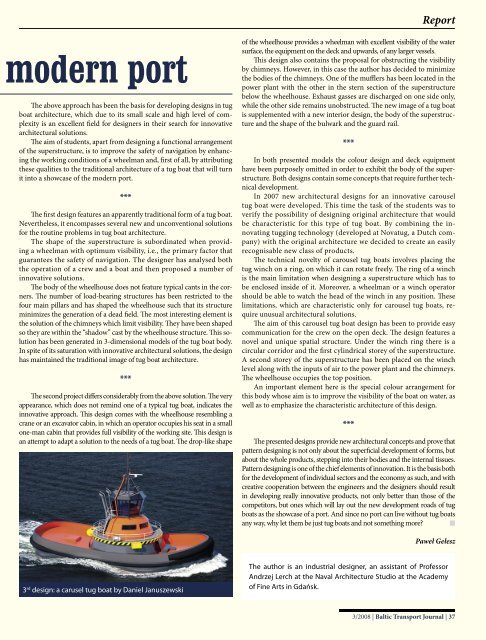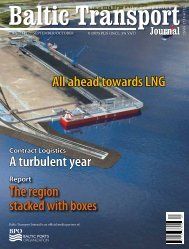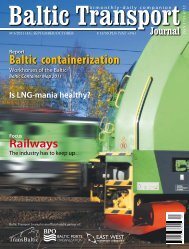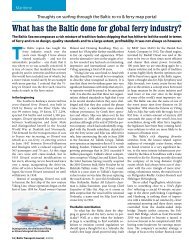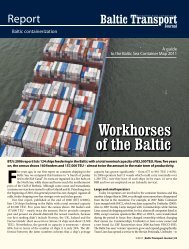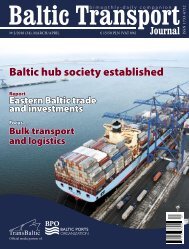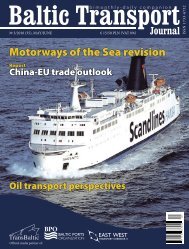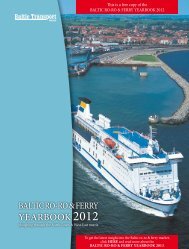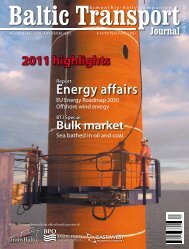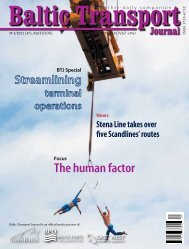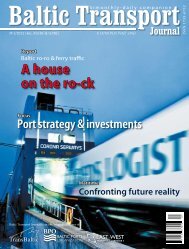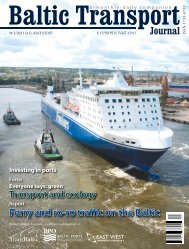Create successful ePaper yourself
Turn your PDF publications into a flip-book with our unique Google optimized e-Paper software.
modern port<br />
The above approach has been the basis for developing designs in tug<br />
boat architecture, which due to its small scale and high level of complexity<br />
is an excellent field for designers in their search for innovative<br />
architectural solutions.<br />
The aim of students, apart from designing a functional arrangement<br />
of the superstructure, is to improve the safety of navigation by enhancing<br />
the working conditions of a wheelman and, first of all, by attributing<br />
these qualities to the traditional architecture of a tug boat that will turn<br />
it into a showcase of the modern port.<br />
***<br />
The first design features an apparently traditional form of a tug boat.<br />
Nevertheless, it encompasses several new and unconventional solutions<br />
for the routine problems in tug boat architecture.<br />
The shape of the superstructure is subordinated when providing<br />
a wheelman with optimum visibility, i.e., the primary factor that<br />
guarantees the safety of navigation. The designer has analysed both<br />
the operation of a crew and a boat and then proposed a number of<br />
innovative solutions.<br />
The body of the wheelhouse does not feature typical cants in the corners.<br />
The number of load-bearing structures has been restricted to the<br />
four main pillars and has shaped the wheelhouse such that its structure<br />
minimizes the generation of a dead field. The most interesting element is<br />
the solution of the chimneys which limit visibility. They have been shaped<br />
so they are within the “shadow” cast by the wheelhouse structure. This solution<br />
has been generated in 3-dimensional models of the tug boat body.<br />
In spite of its saturation with innovative architectural solutions, the design<br />
has maintained the traditional image of tug boat architecture.<br />
***<br />
The second project differs considerably from the above solution. The very<br />
appearance, which does not remind one of a typical tug boat, indicates the<br />
innovative approach. This design comes with the wheelhouse resembling a<br />
crane or an excavator cabin, in which an operator occupies his seat in a small<br />
one-man cabin that provides full visibility of the working site. This design is<br />
an attempt to adapt a solution to the needs of a tug boat. The drop-like shape<br />
3 rd design: a carusel tug boat by Daniel Januszewski<br />
Report<br />
of the wheelhouse provides a wheelman with excellent visibility of the water<br />
surface, the equipment on the deck and upwards, of any larger vessels.<br />
This design also contains the proposal for obstructing the visibility<br />
by chimneys. However, in this case the author has decided to minimize<br />
the bodies of the chimneys. One of the mufflers has been located in the<br />
power plant with the other in the stern section of the superstructure<br />
below the wheelhouse. Exhaust gasses are discharged on one side only,<br />
while the other side remains unobstructed. The new image of a tug boat<br />
is supplemented with a new interior design, the body of the superstructure<br />
and the shape of the bulwark and the guard rail.<br />
***<br />
In both presented models the colour design and deck equipment<br />
have been purposely omitted in order to exhibit the body of the superstructure.<br />
Both designs contain some concepts that require further technical<br />
development.<br />
In 2007 new architectural designs for an innovative carousel<br />
tug boat were developed. This time the task of the students was to<br />
verify the possibility of designing original architecture that would<br />
be characteristic for this type of tug boat. By combining the innovating<br />
tugging technology (developed at Novatug, a Dutch company)<br />
with the original architecture we decided to create an easily<br />
recognisable new class of products.<br />
The technical novelty of carousel tug boats involves placing the<br />
tug winch on a ring, on which it can rotate freely. The ring of a winch<br />
is the main limitation when designing a superstructure which has to<br />
be enclosed inside of it. Moreover, a wheelman or a winch operator<br />
should be able to watch the head of the winch in any position. These<br />
limitations, which are characteristic only for carousel tug boats, require<br />
unusual architectural solutions.<br />
The aim of this carousel tug boat design has been to provide easy<br />
communication for the crew on the open deck. The design features a<br />
novel and unique spatial structure. Under the winch ring there is a<br />
circular corridor and the first cylindrical storey of the superstructure.<br />
A second storey of the superstructure has been placed on the winch<br />
level along with the inputs of air to the power plant and the chimneys.<br />
The wheelhouse occupies the top position.<br />
An important element here is the special colour arrangement for<br />
this body whose aim is to improve the visibility of the boat on water, as<br />
well as to emphasize the characteristic architecture of this design.<br />
***<br />
The presented designs provide new architectural concepts and prove that<br />
pattern designing is not only about the superficial development of forms, but<br />
about the whole products, stepping into their bodies and the internal tissues.<br />
Pattern designing is one of the chief elements of innovation. It is the basis both<br />
for the development of individual sectors and the economy as such, and with<br />
creative cooperation between the engineers and the designers should result<br />
in developing really innovative products, not only better than those of the<br />
competitors, but ones which will lay out the new development roads of tug<br />
boats as the showcase of a port. And since no port can live without tug boats<br />
any way, why let them be just tug boats and not something more?<br />
Paweł Gełesz<br />
The author is an industrial designer, an assistant of Professor<br />
Andrzej Lerch at the Naval Architecture Studio at the Academy<br />
of Fine Arts in Gdańsk.<br />
3/<strong>2008</strong> | <strong>Baltic</strong> <strong>Transport</strong> <strong>Journal</strong> | 37


